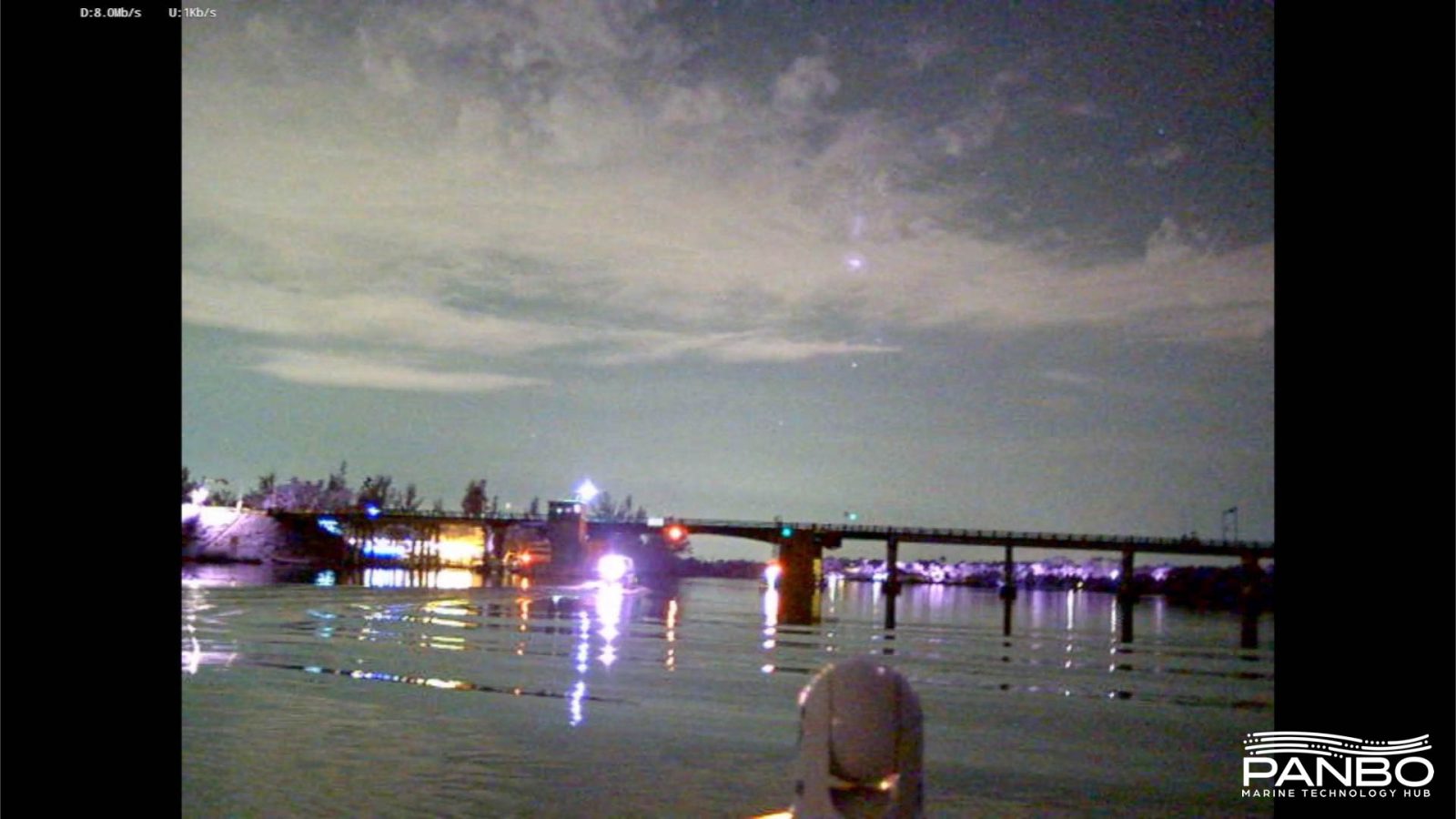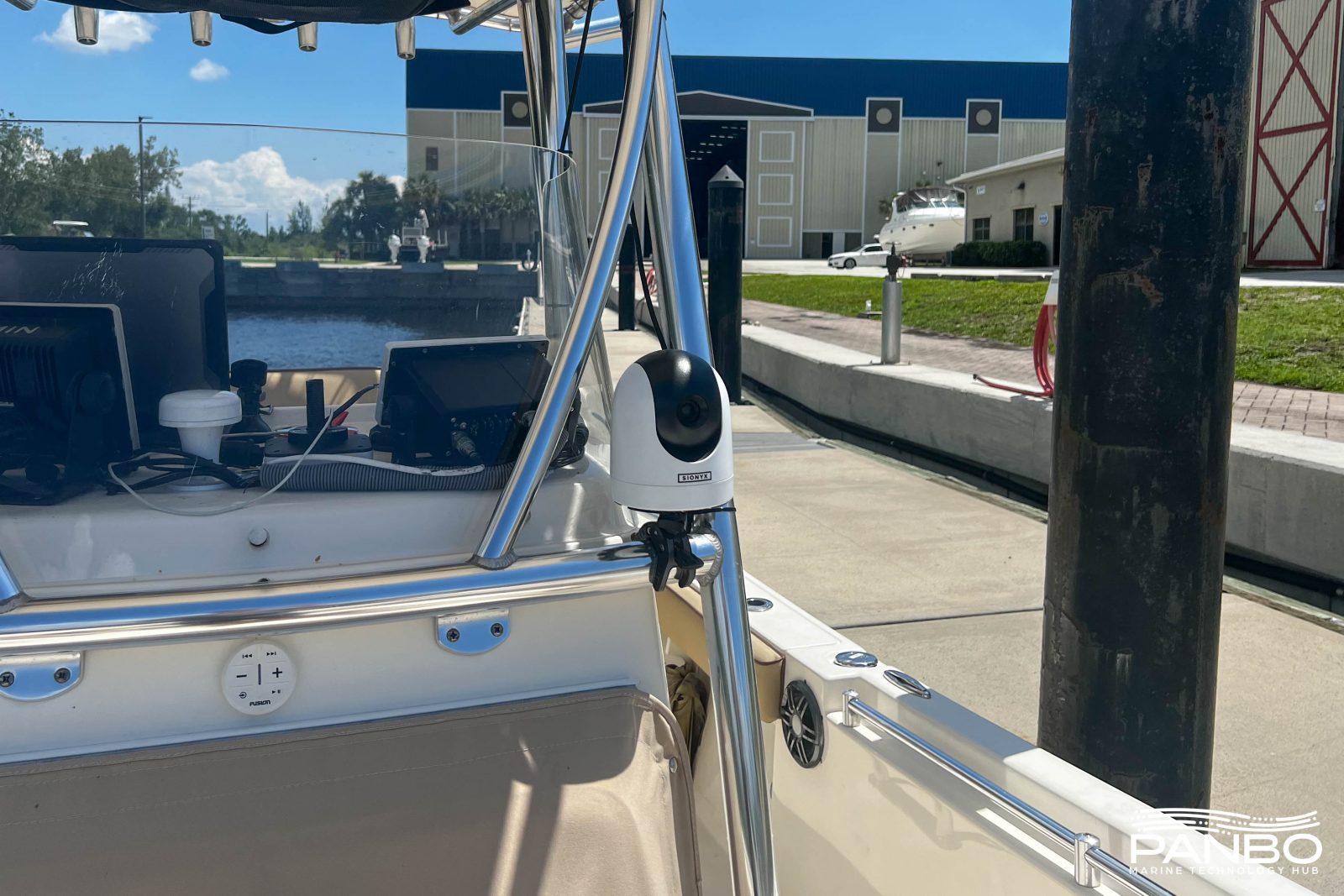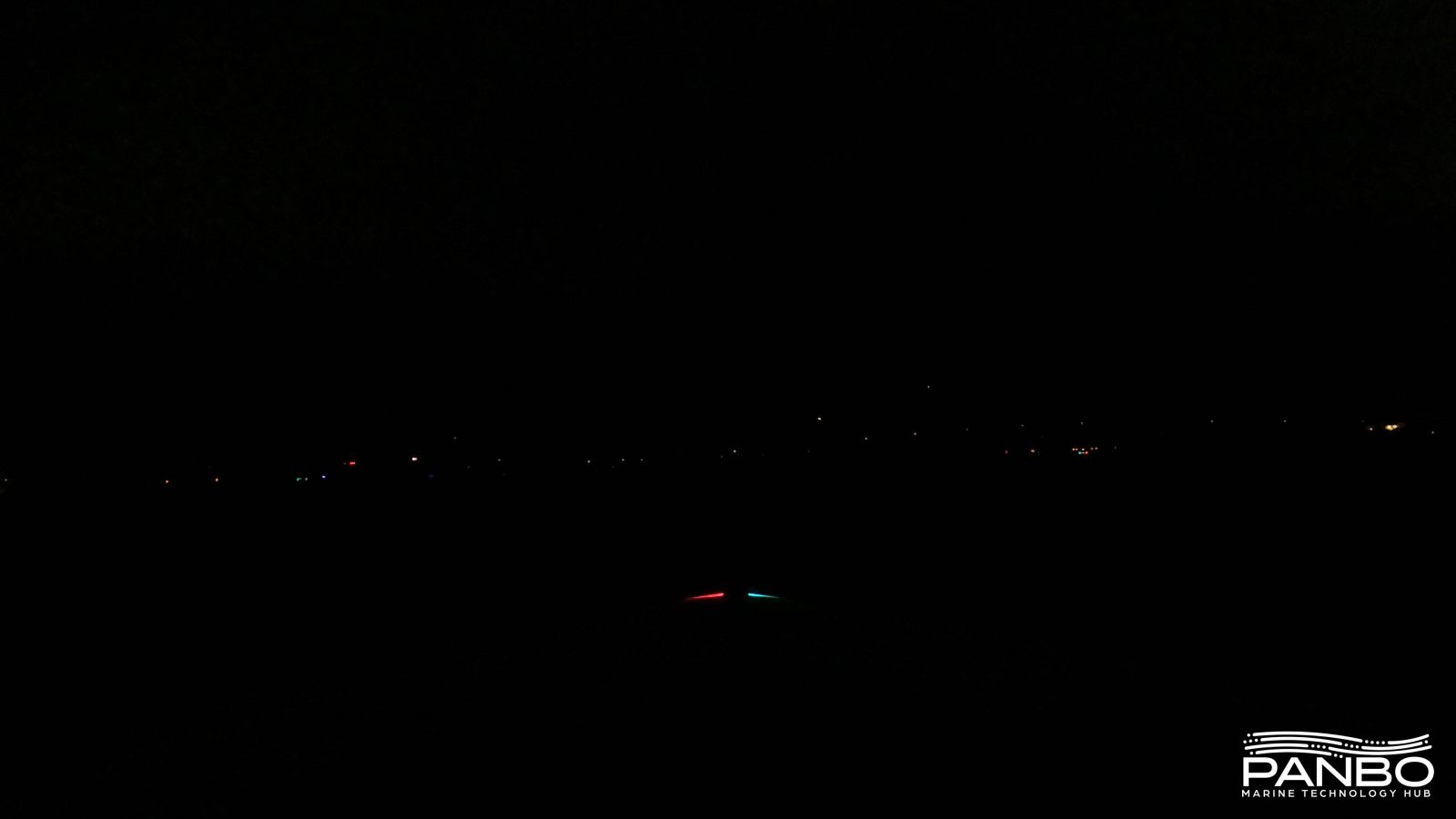SIONYX Nightwave, strong low light performance

SIONYX’s Nightwave camera is the company’s first fixed mount, marine, night vision camera. It builds on the strong low-light performance of the company’s Aurora handheld spotting scopes in a more traditional marine form factor. I’ve had the camera out on some inky dark nights and been pleased with the performance.
I was first introduced to SIONYX’s night vision products during a demo ride at the 2018 Fort Lauderdale Boat Show. That ride left me impressed with their technology and wanting for a mounted version of the camera. I’ve had an Aurora since then and have used it sporadically. I keep it on Panbo((at) and find it useful in the dark, but I also find that its utility is limited by the spotting scope form factor. The Aurora can stream to a Wi-Fi-connected mobile device, but I’ve found that WiFi connection is troublesome.
Last year SIONYX announced a new, fixed-mount camera that not only closes the gap in mounting options but also significantly improves performance. The $1,495 Nightwave offers a 1280×1024 BSI CMOS sensor that SIONYX says can produce a usable image with less than one millilux of light via the 16mm, f1.4 lens. A millilux is the light of a moonless, overcast night. The camera produces a maximum of 30hz or 30 frames per second.
Installation

The five-inch diameter, six-inch tall dome camera is compact and light. It offers either mounting via four blind holes in the bottom of the unit or a 1/4-20 threaded hole. I’m using a 1/4-20 clamp mount and it has held the sub two-pound camera nicely.
Nightwave is a fixed camera with manual focus. So, once set in place, you will have a fixed 44-degree field of view. Although the camera is manual focus, I set the focus once and never needed to adjust focus again. In fact, I’d forgotten it was manual focus until I wrote this review.
The camera outputs via an analog video output or WiFi connectivity for use with their app on a tablet or phone. Those two connectivity options come as a bit of a disappointment. I am hoping for HTML5 output or RTSP or similar streaming protocols to enable streaming the camera’s output to installed MFDs on the boat. But, since the camera’s connection will be made via WiFi, the only wiring I needed to complete was supplying power.
I captured all of the Nightwave footage via a tablet setup at the helm. Because the Nightwave app currently doesn’t support recording, all the videos were recorded using Android’s native screen recording capabilities.
Performance

I pulled the boat off the dock as the sun was setting. I set out with a GoPro Hero 9, a FLIR M364C dual payload thermal camera, and my iPhone 13 Pro as the sun was setting.
In the last minutes of full daylight, the GoPro, FLIR (set to visible light), and iPhone all produced clear images with natural-looking colors. The SIONYX camera produced clear, bright images but with a purple shift to many colors. Green items, like trees, especially showed purple.
Quickly, as the sun dipped below the horizon and light faded, the GoPro’s image was the first to fade to nearly complete black. Just a few minutes after the sun had set and light was reduced to a fading glow on the horizon, the only features visible on the GoPro’s image were light sources.
At these light levels, the iPhone, FLIR, and both SIONYX cameras were still performing very well. As you will see in a moment, I’ve included a few image comparison sliders below. Unfortunately, with different fields of view, these didn’t work out as well as I would have liked.
The still comparison above shows the results of both the Nightwave and the FLIR M364C. These shots were taken a few minutes after last light. The SIONYX’s image shows how much light its sensor still sees. The FLIR image is fully thermal. A noteworthy difference between the two images is that the FLIR picture won’t change with more or less light. In contrast, the SIONYX image will probably get a little noisier as the very last light fades over the horizon.

One of the challenges of a review like this is helping readers understand how much the cameras are doing with very little light. I think the image above might help. This is a screengrab from a video I took on a GoPro Hero 9. I promise it’s not all black; if you look in the middle of the image, you can see the running lights. But contrast this image with what Nightwave produces, and the results become even more impressive.
I captured the clip above about 50 minutes after sunset and 25 minutes after last light. All the captures shown in this article come from a sparsely populated section of the Caloosahatchee River about 15 miles upriver from downtown Fort Myers. The moon was a sliver and the sky was pretty clear, so there was a very small amount of ambient light. With the naked eye, I could make out very little detail though I could mostly tell where the river banks lay. The image from the Nightwave’s camera, displayed on a tablet at the helm, was surprisingly clear and easy to interpret. I felt I had plenty of visual information to safely run at my 5-8 knot speed.
I thought it was interesting to see the lightning in the sky in the videos. I noticed that showing up on the tablet’s screen while I couldn’t see any of that activity with my naked eye.
FLIR’s thermal cores aren’t reliant on visible, nearly visible, or any other light. Instead, they produce an image by showing the heat of objects in view of each pixel of the thermal core in the camera. I used a FLIR M364C for these comparisons. At $33,000, it’s 22 times as expensive as the Nightwave. The C version of the camera I’m using has both a thermal and visible light sensor, a 30x optical zoom on the visible light camera. The M364C can combine both visible light and thermal images to overlay some color over the monochrome thermal image. But, in my testing in extremely low light, the visible light sensor switched to black and white and wasn’t able to provide enhancement to the images
Until the sun had fully set, I was impressed with the job the iPhone camera was doing capturing video. In fact, I was starting to wonder if it was going to show up the specialty night vision cameras. Well, as last light faded, that wondering stopped. The video above, like the other Nightwave and M364C clips, was recorded at 8:43 PM or 25 minutes after light. I took a few subsequent videos and they were even darker, verging ever closer to the GoPro’s results.
I haven’t used all of the FLIR camera’s capabilities for this comparison, so I don’t think it’s fair to draw conclusions about value. But, strictly comparing nighttime navigation assistance, I can tell you that I found the image returned by the SIONYX camera to be easier to process at a glance. Part of that may come from familiarity; like any tool, the more you use it, the more adept you will come at interpreting the results. Because Nightwave’s images are based on light, not heat, they are more familiar and hence should take less adjustment.
Added 5/2/2023 – Visible light cameras compared
Technical difficulties (okay user error) had previously prevented me from publishing this video. I think it provides an interesting comparison of the visible light camera in the FLIR M364C against the camera in the Nightwave. In low light, Nightwave produces clearer images and is able to do so well past the point where the FLIR’s visible light sensor’s image is mostly noise. But, the FLIR’s 30x optical zoom and pan and tilt capabilities make it useful in other applications for which Nightwave really isn’t suited.
It’s also worth noting that FLIR sells a version of the M300 with just the visible light camera. That option is called the M300C, it includes the 1920×1080 30hz sensor, pan, tilt, and zoom capabilities with a 30x optical zoom, and gyro stabilization. The camera can deliver it’s video via, NTSC analog outputs, SDI lossless HD, and H.264 MJPEG IP streams. It has a suggested list of $6,995.
Final thoughts
SIONYX’s Nightwave addresses several of the limitations of its previous model. Notably, permanent mounting, easy 12-volt power connections, and a more hardened and marinized package. But there’s still room for improvement with how the image is delivered to the user. I would really like to see an HTML5 integration that allows modern chartplotters to connect via Ethernet and stream the Nightwave images.
Those concerns notwithstanding, for $1,500 dollars, Nightwave produces clear, easy-to-understand images that genuinely improve safety at night. When I started my testing, I expected to have complaints about the fixed mount of the camera and the inability to pan or tilt the image. The truth is, during my testing, I never wanted for that capability. Even if you already own an Aurora, I believe Nightwave is a significant upgrade and a wise investment if you find yourself on the water at night regularly.













Would you be able to use the android of the app on the Raymarine Axiom platform via wifi?
Great article.
Thanks,
Curious about the daytime performance… Would this be an effective camera mounted aloft on a mast for enhanced daytime situational awareness as well? I know there are certainly better resolution options that are cheaper just trying to understand if the Sionyx is dual use case or not.
We’re you able to see crab pots or small bouts in the water with the Sionyx?
How do you think the Nightwave would be able to find a MOB in the dark? I would think that the Flir’s heat sensing format would be superior. I have the pretty basic Flir M232 and thankfully haven’t had to use it for an MOB but it sure works great while on the hook at 2am to check out the surroundings, especially with the pan and tilt features. Thanks for a great comparison.
Ben-
I noticed that in the 5/2 Video that the FLIR camera that is mounted well forward, seems to be getting “jammed” by the nearby red and green Navigation lite. I can see noisy red and green bands to the left of center that stays in place at all times. I wonder if that would improve with the lights turned off for a few moments during the test.
Keith,
You’re right about that and I am very bothered by the visible interference I captured. It’s my fault for the placement of the camera. I noticed it while I was out and captured some video with the running lights off. I guess I should say I thought I captured it because in reviewing the footage I couldn’t find it. I didn’t notice an appreciable difference but am disappointed not to have the cleaner video.
-Ben S
I’ve used a FLIR for 12 years. One major issue is that it depends on infrared radiation. I found that several hours after dark, buoys will cool down after dark to sea temperature and become invisible. Occ a small sail boat at anchor with no lights on and a small engine that cools down quickly with no one on board will also cool down and not be visible.
The best night vision is a generation 2 or 3 photomultiplier scope and nothing compares to that. Unfortunately they are prohibitively expensive. The military use them for night spotting. The faint light of a few stars is enough to activate the phosphors.
The best night vision is a military grade multispectral camera.
Unfortunately they are prohibitively expensive and ITAR controlled items.
Also goes by name “hyperspectral camera”.
It would have been interesting to see how the FLIR compared when the optical camera was used. It is supposed to be good down to near infrared
The video I added on 5/2 does show the performance of the optical camera. I also plan a full review of the M364C.
-Ben S.
Thx, see that now. Did the FLIR gather more light when it wasn’t zoomed?
The Nightwave also reaches into the near infra-red as well, and into IR as well. It sees the 400-1200NM spectrum, where visible light is 400-700NM, near-iR is 700-1000NM, and IR is 1000-8000NM. This isn’t the same as Thermal IR, which is 8000-14000NM.
It would have been interesting to see how well the FLIR camera compared. It is supposed to be good down to near infrared
Ben, I agree that IP boat cameras are nice, but don’t most MFDs still come with one or two analog (NTSC/PAL) video inputs? To me that seems like an easy-to-setup and reliable way to use a fixed nav cam like the Nightwave, especially for skippers who’d rather not mess with a tablet (which may also be overly bright in dark conditions).
I realize that networking the video to multiple helms may be important on some boats, but I think that some high-end MFDs can convert analog video into streaming IP video, right? And since most MFDs support a screen mirror app, isn’t that a possible second-station analog camera workaround?
You’re right that many MFDs do still have analog NTSC and PAL inputs but many (most?) of the entry level don’t. For example, Panbo(at) has a Garmin 943, Raymarine Axiom+ 9”, and 9” Simrad NSX. Of those three MFDs, only the Garmin supports analog video input. I think it’s reasonable to expect with Raymarine and Simrad having dropped the feature that Garmin may well follow in future models.
-Ben S
Well, dang, the bigger NSX and Axiom+ models don’t seem to have analog video inputs either, apparently a trend I had not noticed. But I see that the Axiom Pros have dual analog inputs and can also network their video streams. And here’s hoping that the must-be-coming Simrad NSX “Pro” (or whatever it will be called) includes the same video input flexibility.
You could use a video to IP encoder.
The one thing I like in my PTZ camera, is I can park it facing the rear when it’s not in use, when I know there’s a ton of salt spray coming, etc…. My fixed bullet camera takes a beating from the rain and salt spray that hits it, so I often then use the PTZ when I really need to see (it also has a self drying mode that is helpful).
So even without PTZ, it’d be nice if there were a mechanical shutter.
How do these cameras do in the fog?
Next week in Miami, Syonix will introduce “an enhanced version of the best-selling Nightwave marine color digital night vision camera” but the short press release does not reveal what those enhancements are.
Question: Can the Syonix be used during daylight? Backup camera?
It can. The camera works very well in full daylight, though it does have a purple tinge to the image.
-Ben S.
But I’ll add that the Nightwave is a fixed camera with a 44° horizontal field of view, so it’s not well suited to backing into a slip if that’s what you mean by ‘backup’.
I’d also add there are cameras with higher resolution and crisper image that are better suited as a backup camera, that are also a LOT less expensive. That’s not to take away from the Sionyx, which is built for a different purpose. Some have enough low-light performance and IR illuminators that would work the short distances in a slip-backing situation.
So what did they introduce? I’ve not been able to find anything online indicating an enhancement.
Thx guys, I suspected that wouldn’t be focused well for a backup camera, but still nice to know whose coming up behind you.